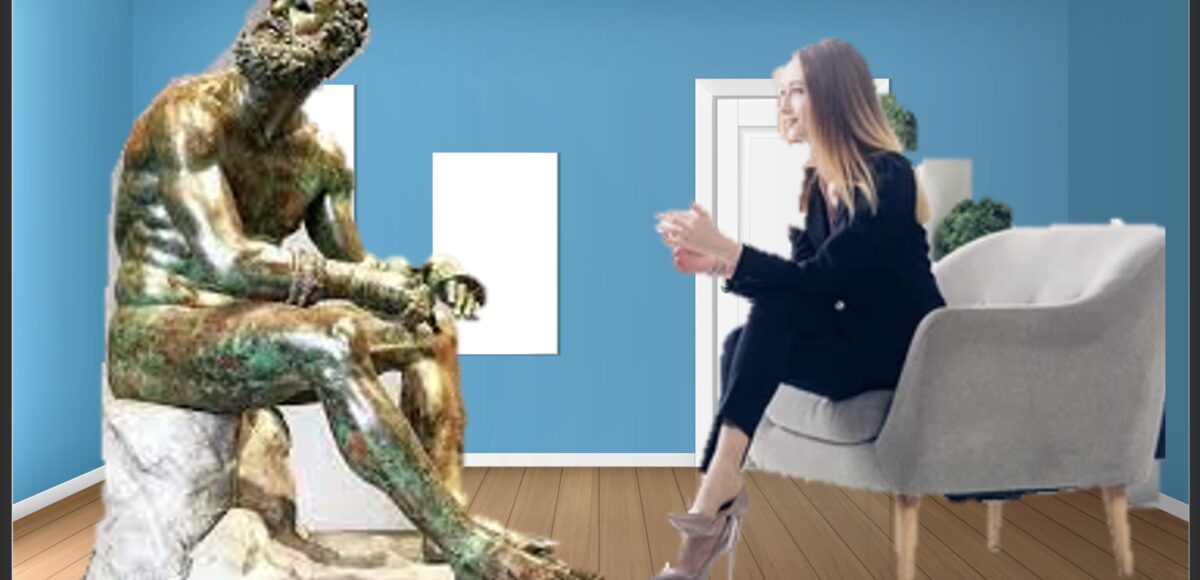Interviewer: Good evening, everyone, I’m Grace LaBruno, and tonight on 60 Minutes, we will chat with one of the world’s favorite ancient athletes, The Seated Boxer. Welcome to the studio, sir.
Seated Boxer: Great to be here!
Interviewer: Let’s start by getting to know some basic information about you. Where and when are you from?
Seated Boxer: Well, I’m a Greek Hellenistic sculpture, and I was created in about 100 BC. That’s not an exact date, though; I’m so old I forgot my creation date.
Interviewer: You’re from the Hellenistic era? I’ve heard that many original bronze sculptures from Ancient Greece were melted down and reused. How did you manage to survive?
Seated Boxer: Honestly, I was just lucky. Seeing my brethren melted down and used for other purposes was heartbreaking. We lost a lot of good men back then.
Interviewer: Speaking of other sculptures, I’ve been told you’re unique compared to your other bronze Hellenistic counterparts: why is that?
Seated Boxer: During my time, statues were usually meant to look noble. They were sculpted in standing positions to show off their ideal bodies and heroic nature. The fact that I’m sitting makes me a bit more down to earth to ordinary people.
Statue of a Victorious Youth, 300–100 B.C.

Victorious Athlete, 340-330 B.C.
Interviewer: I think you’re definitely relatable to the average person. The story of what you’re meant to represent is quite fascinating. Can you tell me about that?
Seated Boxer: During my construction, my sculptor always mumbled about how he wanted to represent suffering and loss of youth, an athlete no longer in his prime. He sculpted me with a bloody gash in my head made of copper, a broken nose, and swollen ear. He had me seated in nothing but my boxing gloves, absolutely exhausted. Even my skin was made to look blotchy from age and years of physical brutality.
Seated Boxer facial close-up
Seated Boxer Side Profile and Shoulder
Interviewer: Your story is definitely one many people can relate to, athlete or not. Your rise in popularity amongst the art community has given you some unique opportunities, isn’t that right?
Seated Boxer: Well, I’ve been kept in Italy for some time now, but it’s not my home. The Romans conquered Greece and placed me in a bathhouse. I heard many of the Romans there call it the Baths of Constantine. I kept myself entertained by listening to the patrons talk amongst themselves and go about their daily activities. Eventually, the Romans buried me underground. It was a really boring and lonely 1,500 years. Everyday I waited for someone to find me until one day archaeologists dug me up in 1885. They brought me to the Palazzo Massimo alle Terme. Being at the museum was a big adjustment. I had never been surrounded by so many fellow statues before or mobs of people taking pictures of me.
Seated Boxer from Palazzo Massimo alle Terme
Quirinal Hill, Rome Excavation Site 1885
Interviewer: Now that you’re no longer buried, are there any places beside Italy you’ve visited?
Seated Boxer: I was sent to the Metropolitan Museum of Art as part of a temporary exhibition. It was nice to travel and be recognized by millions of people, but the plane ride was terrifying. I was scared I was going to break on the journey. Thank the gods I didn’t sustain any damage. Honestly, I’d rather be back in Greece than New York City.
Interviewer: Why is that?
Seated Boxer: Some other artworks, like Cleopatra’s Needle, have gone through the same thing as me. We are removed from our homeland and end up in a foreign country because of imperial efforts. Many years ago, the Romans stole me from the Greeks to appropriate their powerful legacy and show the triumph of the Roman Empire’s conquests. Now, Italy temporarily gave me to the Met so the museum and its patrons could display how cultured they are by having art pieces from Ancient Greece.
Interviewer: Do you think you’ll ever return to Greece?
Seated Boxer: Maybe one day, but for now, I think I’m staying in Rome for a while.
Interviewer: Well, sir, unfortunately, our interview time is up, but it was wonderful to speak to you tonight.
Seated Boxer: Thank you for letting me share my story.
Interviewer: Our program has ended tonight, but tune in to 60 Minutes next week for a fascinating interview with the Sphinx. Thank you, and goodnight.
A note from the author: My name is Grace LaBruno, and I’m a sophomore at Colgate University. I’ve always been fascinated with Greek art since childhood, so the Seated Boxer was the perfect piece to write about. Additionally, 60 Minutes was a tv program I grew up frequently watching, so it inspired me for the format of my post!
